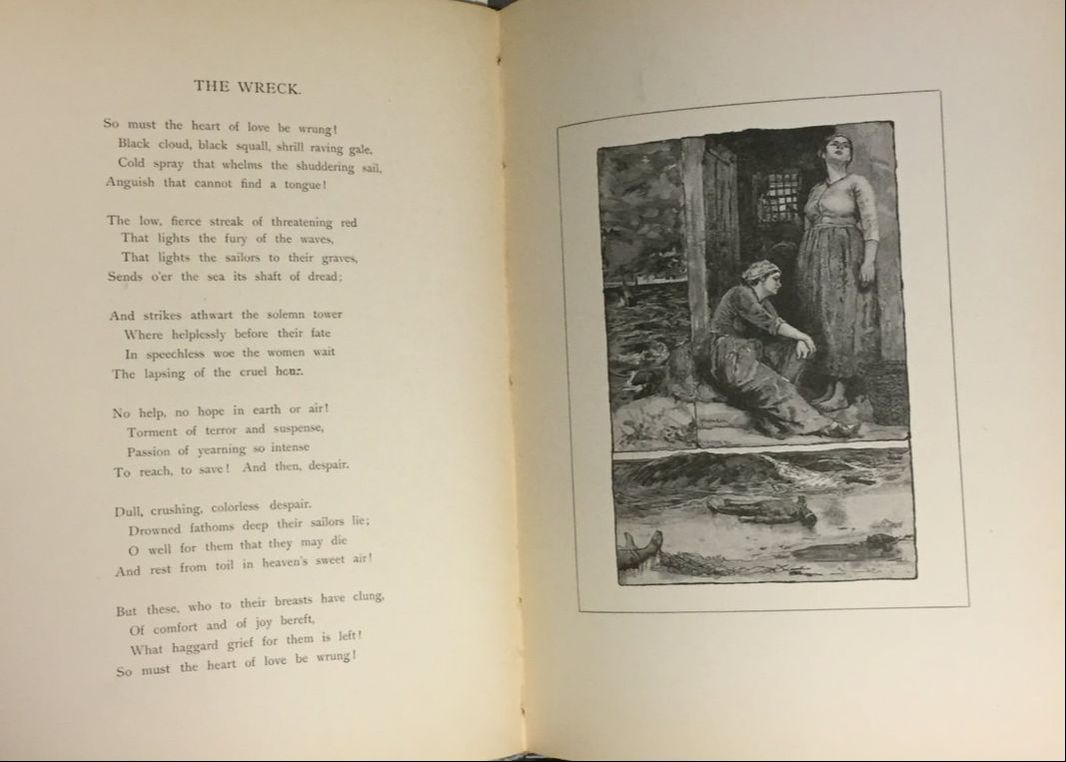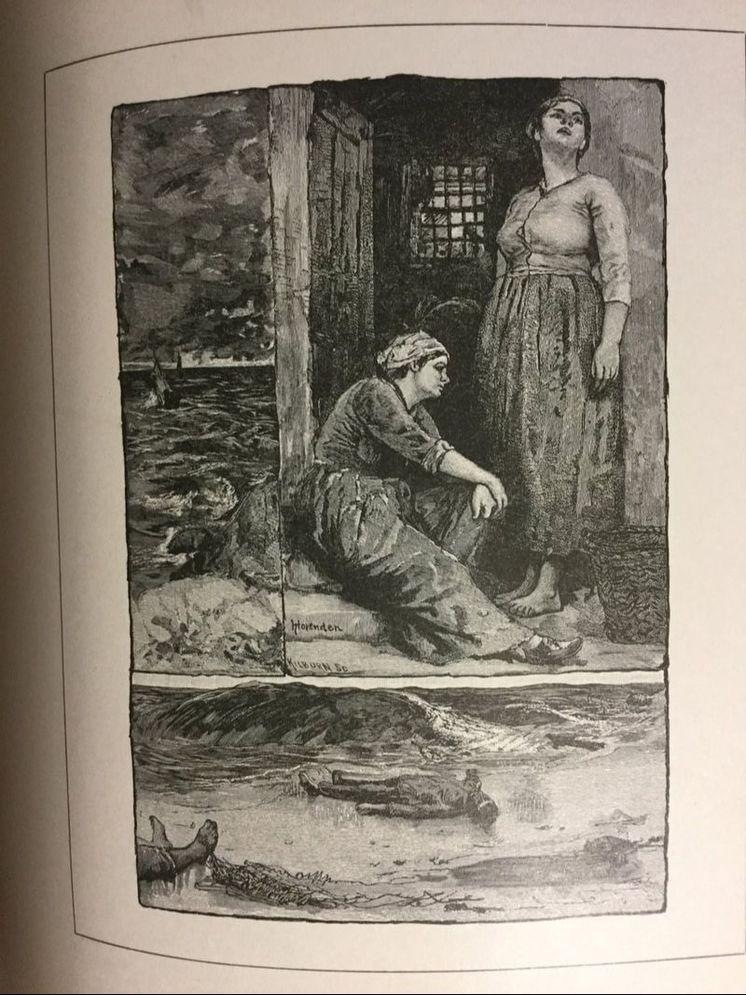Thomas Hovenden and Celia Thaxter
The following is a poem from Celia Thaxter's Verses, and is accompanied by one of Thomas Hovenden's illustrations. This illustration was originally meant to depict Charles Kingsley's classic poem-ballad "The Three Fishers," which seems to also have been influential in Thaxter's subject matter for her poem.
The Wreck
(by Celia Thaxter)
So must the heart of love be wrung!
Black cloud, black squall, shrill raving gale,
Cold spray that whelms the shuddering sail,
Anguish that cannot find a tongue!
The low, fierce streak of threatening red
That lights the fury of the waves,
That lights the sailors to their graves,
Sends o'er the sea its shaft of dread;
And strikes athwart the solemn tower
Where helplessly before their fate
In speechless woe the women wait
The lapsing of the cruel hour.
No help, no hope in earth or air!
Torment of terror and suspense,
Passion of yearning so intense
To reach, to save ! And then, despair.
Dull, crushing, colorless despair.
Drowned fathoms deep their sailors lie;
O well for them that they may die
And rest from toil in heaven's sweet air!
But these, who to their breasts have clung,
Of comfort and of joy bereft,
What haggard grief for them is left!
So must the heart of love be wrung!
(by Celia Thaxter)
So must the heart of love be wrung!
Black cloud, black squall, shrill raving gale,
Cold spray that whelms the shuddering sail,
Anguish that cannot find a tongue!
The low, fierce streak of threatening red
That lights the fury of the waves,
That lights the sailors to their graves,
Sends o'er the sea its shaft of dread;
And strikes athwart the solemn tower
Where helplessly before their fate
In speechless woe the women wait
The lapsing of the cruel hour.
No help, no hope in earth or air!
Torment of terror and suspense,
Passion of yearning so intense
To reach, to save ! And then, despair.
Dull, crushing, colorless despair.
Drowned fathoms deep their sailors lie;
O well for them that they may die
And rest from toil in heaven's sweet air!
But these, who to their breasts have clung,
Of comfort and of joy bereft,
What haggard grief for them is left!
So must the heart of love be wrung!
The Three Fishers
(by Charles Kingsley)
Three fishers went sailing out into the West,
Out into the West as the sun went down;
Each thought on the woman who lov’d him the best;
And the children stood watching them out of the town;
For men must work, and women must weep,
And there's little to earn, and many to keep,
Though the harbour bar be moaning.
Three wives sat up in the light-house tower,
And they trimm’d the lamps as the sun went down;
They look’d at the squall, and they look’d at the shower,
And the night wrack came rolling up ragged and brown!
But men must work, and women must weep,
Though storms be sudden, and waters deep,
And the harbour bar be moaning.
Three corpses lay out on the shining sands
In the morning gleam as the tide went down,
And the women are weeping and wringing their hands
For those who will never come back to the town;
For men must work, and women must weep,
And the sooner it's over, the sooner to sleep--
And good-by to the bar and its moaning.
(by Charles Kingsley)
Three fishers went sailing out into the West,
Out into the West as the sun went down;
Each thought on the woman who lov’d him the best;
And the children stood watching them out of the town;
For men must work, and women must weep,
And there's little to earn, and many to keep,
Though the harbour bar be moaning.
Three wives sat up in the light-house tower,
And they trimm’d the lamps as the sun went down;
They look’d at the squall, and they look’d at the shower,
And the night wrack came rolling up ragged and brown!
But men must work, and women must weep,
Though storms be sudden, and waters deep,
And the harbour bar be moaning.
Three corpses lay out on the shining sands
In the morning gleam as the tide went down,
And the women are weeping and wringing their hands
For those who will never come back to the town;
For men must work, and women must weep,
And the sooner it's over, the sooner to sleep--
And good-by to the bar and its moaning.
Discussion points / questions / activities
- Which interpretation---music, poetry, or image--best captures the experience of these women waiting for their sailors / lovers to return?
- Perry Westbrook in his essay "Celia Thaxter's Controversy with Nature" writes that "[Celia Thaxter] is among the first American writers to view nature as indifferent, if not downright hostile, to man." Indeed, some of her poems are "reminiscent in mood of many of the later realists, of such works, for example, as Crane's 'The Open Boat' or London's "To Build a Fire" (Westbrook p. 492)
- More thoughts from Westbrook: "[Nature's indifference to man] is the tone of the majority of Celia Thaxter's poems. The meaningless destruction of birds and flowers, shipwreck, drownings, the bereavement of women whose men have been lost at sea, all appear to her as evidence of an unfeeling, a mechanistic Nature." This attitude was "unique in the America of her day" (493-494)
REFERENCES
Thaxter, Celia. Celia Thaxter: Verses. Print.
→ Crystal Bridges Museum Library Call Number: PS3012 .V4 1891
Westbrook, D. Perry. "Celia Thaxter's Controversy with Nature." The New England Quarterly, Vol. 20, No. 4
(Dec., 1947), pp. 492-515
Thaxter, Celia. Celia Thaxter: Verses. Print.
→ Crystal Bridges Museum Library Call Number: PS3012 .V4 1891
Westbrook, D. Perry. "Celia Thaxter's Controversy with Nature." The New England Quarterly, Vol. 20, No. 4
(Dec., 1947), pp. 492-515


